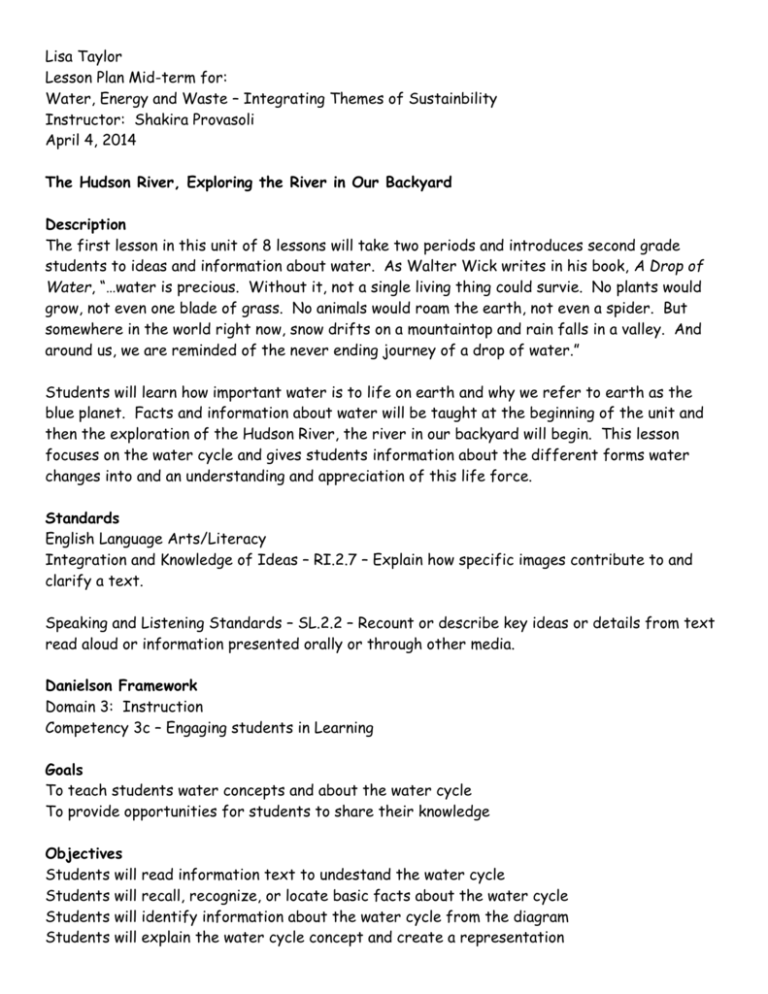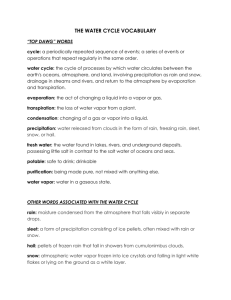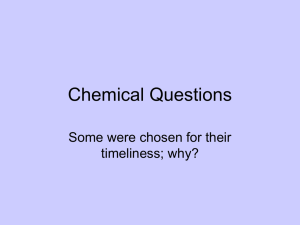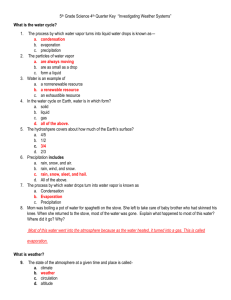HR - WasteWaterEnergy
advertisement

Lisa Taylor Lesson Plan Mid-term for: Water, Energy and Waste – Integrating Themes of Sustainbility Instructor: Shakira Provasoli April 4, 2014 The Hudson River, Exploring the River in Our Backyard Description The first lesson in this unit of 8 lessons will take two periods and introduces second grade students to ideas and information about water. As Walter Wick writes in his book, A Drop of Water, “…water is precious. Without it, not a single living thing could survie. No plants would grow, not even one blade of grass. No animals would roam the earth, not even a spider. But somewhere in the world right now, snow drifts on a mountaintop and rain falls in a valley. And around us, we are reminded of the never ending journey of a drop of water.” Students will learn how important water is to life on earth and why we refer to earth as the blue planet. Facts and information about water will be taught at the beginning of the unit and then the exploration of the Hudson River, the river in our backyard will begin. This lesson focuses on the water cycle and gives students information about the different forms water changes into and an understanding and appreciation of this life force. Standards English Language Arts/Literacy Integration and Knowledge of Ideas – RI.2.7 – Explain how specific images contribute to and clarify a text. Speaking and Listening Standards – SL.2.2 – Recount or describe key ideas or details from text read aloud or information presented orally or through other media. Danielson Framework Domain 3: Instruction Competency 3c – Engaging students in Learning Goals To teach students water concepts and about the water cycle To provide opportunities for students to share their knowledge Objectives Students will read information text to undestand the water cycle Students will recall, recognize, or locate basic facts about the water cycle Students will identify information about the water cycle from the diagram Students will explain the water cycle concept and create a representation Materials Books, listed below Printed copies of water cycle diagram from World Book Online Printed copies of water cycle article from World Book Online Computer, Internet Access and Interactive whiteboard or projector Printed copies of Water Cycle Wheel Hand-outs Pencils, colored pencils and crayons Metal fasteners, scissors and glue Procedure/Methods Open lesson with students seated on the rug and read aloud, 2pp, from B is for Blue Planet, An Earth Science Alphabet: “…W is for water cycle. Liquid, gas, and solid – water is all three. In the air and on the ground, in a cycle round and round, collected in the sea. Water is a basic ingredient for life. And it’s the only substance we know of that can exist naturally as a gas, liquid, and a solid.” Read through to end and ask students to respond with different examples of water in each of the three different states. Informal assessment of students’ responses. Clarify and reteach any confusing concepts ie.: “The continuous change of water from liquid to gas to solid is called the water cycle, or hydrolic cycle. Energy from the sun powers the cycle.” Tell students we are going to move to the tables to do more research and access information from World Book Online Encyclopedia. Use the interactive whiteboard to present the water cycle diagram and read more information about the water cycle. Demonstrate and review steps in online research: 1. 2. 3. 4. 5. 6. Launch web browser Type URL: www.worldbookonline.com Enter Log-In and Password Select Kids Search term: water cycle Access Diagram: “Water is always traveling between the land, the air and the bodies of water.” Credit: World Book illustration by John Sandford Read “Water Cycle” article together highlighting key concepts: “The water cycle <<SY kuhl>> is the never-ending movement of Earth's water. Water goes from the oceans to the air to the land and back to the oceans again. For that reason, its movement is called a cycle. This cycle begins when heat from the sun turns ocean water into water vapor. Water vapor is water that has become a gas. The water vapor rises high into the sky, where it cools off. The cooled water vapor changes into tiny drops of water. The drops are held up in the sky by rising warm air. When billions of these drops of water cluster together, they form a cloud. The water in the clouds eventually falls to Earth as rain. If the water vapor is cold enough, it turns into ice and falls as snow. Most rain and snow falls into the ocean, but some falls on land. In time, this water also flows back to the ocean, and the cycle starts again. Because of nature's water cycle, there is as much water on Earth today as there ever was—or ever will be. Water changes only from one form to another, and moves from one place to another. The water you bathed in last night might have flowed in Russia's Volga River last year. Or perhaps Alexander the Great drank that water more than 2,000 years ago. The water cycle is an important and wonderful process. It even helps cool Earth. As water evaporates, it takes in heat from its surroundings. After it takes in heat, it rises from the ground and takes the heat with it. Then the air feels cooler. The water cycle also affects the weather. It creates the clouds that bring the rain and snow. Water from the rain and snow is necessary to all life on Earth.” Discuss article, review elements of the diagram and ask for any questions. Student Activity Pass out materials for “Make a Water Wheel” project and ask students to construct a representation of a water cycle using vocabulary, sketches and drawings to show what they have learned. Provide vocabulary cards for Precipitation, Condensation, Evaporation, and Accumulation. Share - Using water cycle wheels, students will explain aspects of the water cycle to a partner and teacher will informally assess student explanations and discussions. Assessments Throughout the informational text read alouds informally assess students for understanding and comprehension of material. Evoke recall and response from students to gain insight into their understanding of the water cycle concept and new challenging vocabulary. Correct and redirect when needed and ask students to teach you about the cycle in their own words and have them give you new ideas and examples that show their thought process. Formally assess the “Water Wheel” students created during the activity: 4 - outstanding, thoughtful and careful work, deep understanding of key water cycle concepts 3 - completed water cycle representation with competency and understanding 2 – unclear about water cycle and vocabulary, must review key concepts and revise water wheel 1 - little or no real interest and intent - ABSOLUTELY MUST REDO! Resources and Works Cited: Illinois Environmental Protection Agency http://www.epa.state.il.us/kids/fun-stuff/water-cycle/ Lorrie, P. (1992). Hudson river, an adventure from the mountains to the sea. Honesdale, PA: Boyds Mills Press. Patties Classroom http://pattiesclassroom.blogspot.com/2011/04/telling-temperature-of-our-weather.html Strother, R. (2011). B is for blue planet, an earth science alphabet. Ann Arbor, MI: Sleeping Bear Press. Teachers Pay Teachers, An Open Marketplace for Educators http://www.teacherspayteachers.com/Browse/Search:water%20cycle United States Geological Survey’s Water Science School http://water.usgs.gov/edu/watercycle-kids.html Water cycle. (2014). In World Book Kids. Retrieved from http://worldbookonline.com/kids/article?id=ar832164 Wick, W. (1997). A drop of water, a book of science and wonder. New York, NY: Scholastic Press World Book Online Encyclopedia www.worldbookonline.com






